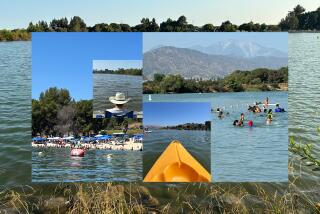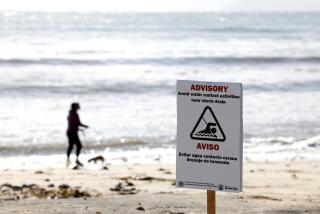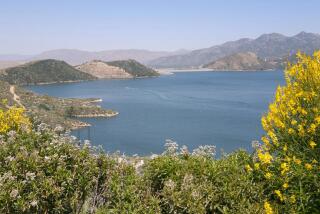Bacteria Level Still High; Castaic Lake Use Restricted
- Share via
Restrictions imposed this summer on weekend use of Castaic Lake, one of the region’s largest boating and swimming facilities, will remain in effect indefinitely as the county explores ways to reduce the bacterial level in the lake’s four designated swimming areas, county officials said Tuesday.
“You just can’t ignore it,” said Brian Roney, assistant superintendent of the lake, referring to water quality tests indicating that on weekends, when the lake’s shallow swimming areas are crowded, the water is unhealthy.
The weekend tests, conducted since July, found high levels of bacteria such as that present in human intestines. The bacteria can cause diarrhea and fever, although Department of Health Services officials stressed that there have been no reports of human illness as a result of the bacterial levels and said the restrictions are precautionary.
To adress the problem, health and recreation officials have limited the number of people allowed to visit the lake to 1,500 carloads at any time, and are limiting the number of swimmers to about 800. No restrictions have been placed on the number of boaters.
The perimeter of the Castaic Lake swimming area, about 10 miles north of Santa Clarita, will remain fenced on weekends to keep out visitors.
The restrictions at the county-operated lake have been in place since July 27. Earlier that month, tests by the Department of Health Services, for the first time in eight years, found that the bacterial levels in Castaic Lake’s swimming areas had climbed to unsafe levels.
Health department officials said drinking water, supplied by an adjacent 2,235-acre reservoir separated from the lake by a dam, is not threatened by the bacteria.
Although tests Aug. 19 and Aug. 26 found safe bacterial levels, the county Department of Parks and Recreation closed the lake’s swim areas during the busy Labor Day weekend.
Tests done over the weekend showed that bacterial levels in the swimming area were unsafe, even though tests done during the week indicated no problems, said Ralph Lopez, the county’s deputy of environmental health. He said he was “taken aback by the results.”
As a result of the troubling test results, he said, the Parks and Recreation Department installed additional portable toilets around the lake and instituted the weekend restrictions.
The county began routinely testing Castaic Lake on weekends only this summer, said Russ Johnson, an environmental health specialist for the Health Services Department. He acknowledged that weekend bacterial levels at the lake may have been unsafe in the past.
“It’s a good question that has come up now and then,” he said. “In the summer, in times past, we never really knew.”
County officials believe the rising bacterial levels reflect increasing use of the lake by swimmers, not contamination from animals or a leak in the sewage system, Roney said. Last year 1.5 million people visited the lake, compared with 900,000 in 1986, he said.
The county previously closed the lake’s swimming areas for much of the summer of 1982 because of high bacteria levels, Roney said. The parks department hired a consultant, at a cost of $30,000, to identify the cause of the problem and ways to solve it.
The consultant determined that the problem was caused by people using the lake and animals emitting waste into it, not by a sewer leak, which would have been simpler to rectify, he said.
After the county installed a submerged aerator to circulate water throughout the lake, weekday tests showed safe levels of bacteria, Roney said.
Another cause of the lake’s high bacterial levels may be the region’s ongoing drought, said Cal Miller, an environmental health specialist for the department. The lack of rain has made the state, which owns the adjacent reservoir, reluctant to release water into the county-owned lake, he said. Thus bacteria in the lake have not been flushed out.
The restrictions on weekend use of the recreational lake have rankled area merchants, who depend on the summer season--especially on holidays such as Labor Day--for much of their business.
“I want to make sure that they’re not screaming wolf,” said Jeff Preach, vice president of the Castaic Chamber of Commerce. He said local businesses have complained to him about the weekend restrictions.
As merchants complain and many weekend swimmers stay dry, county officials are exploring ways to solve what they expect will continue to be a problem at the lake’s beaches, scheduled to close for the summer on Sept. 22. One option, Roney said, is to install a second underwater aerator in the lake, at a cost of $30,000.
Another is to dig up the sand under the swimming areas and lay a system of pipes to inject chlorine into the water during periods of high use. The pipes would cost up to $100,000 to install, he said, and the chlorine needed for an average weekend would cost $1,500.
More to Read
Sign up for Essential California
The most important California stories and recommendations in your inbox every morning.
You may occasionally receive promotional content from the Los Angeles Times.










